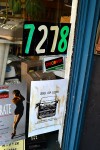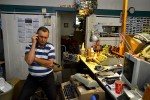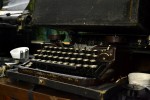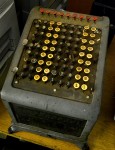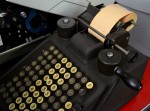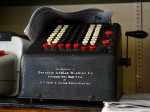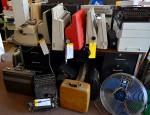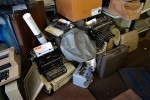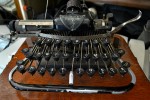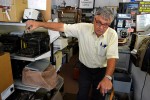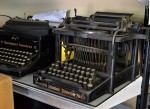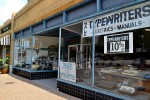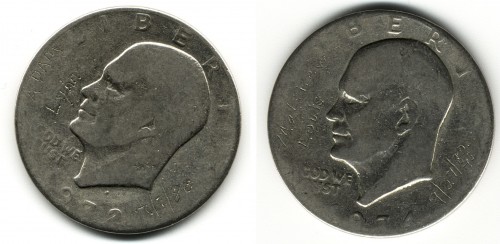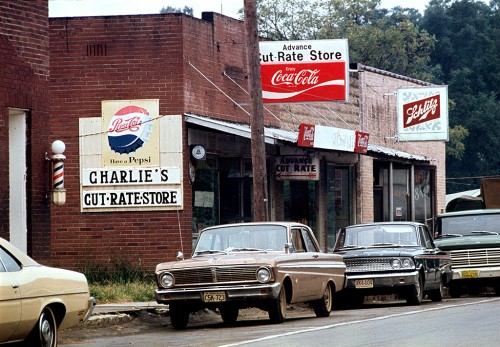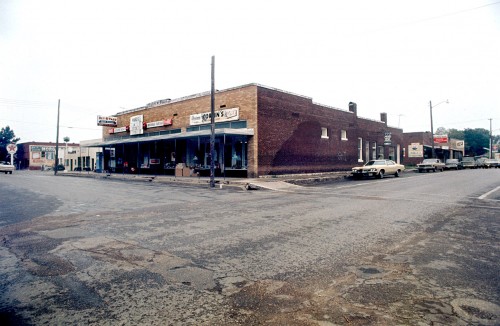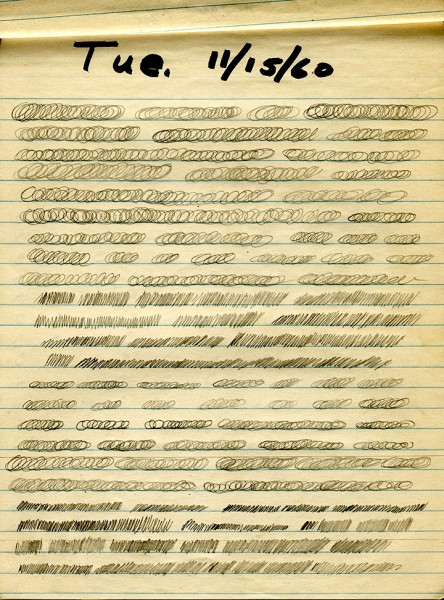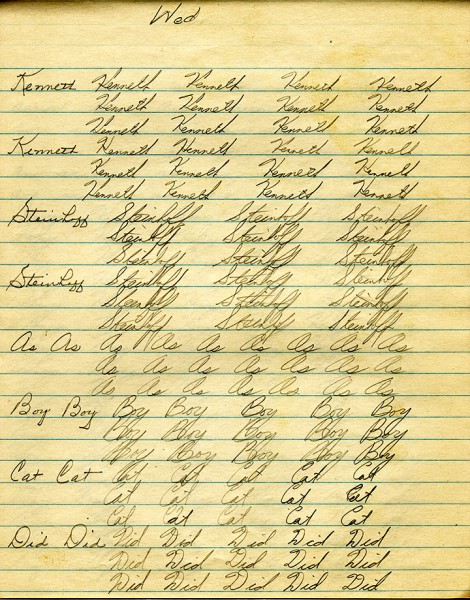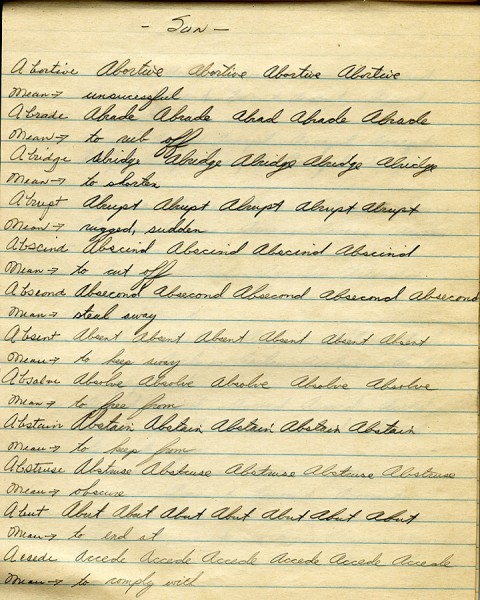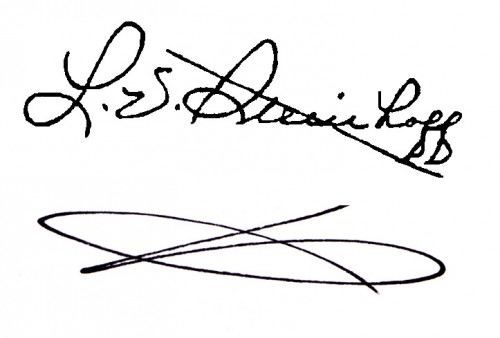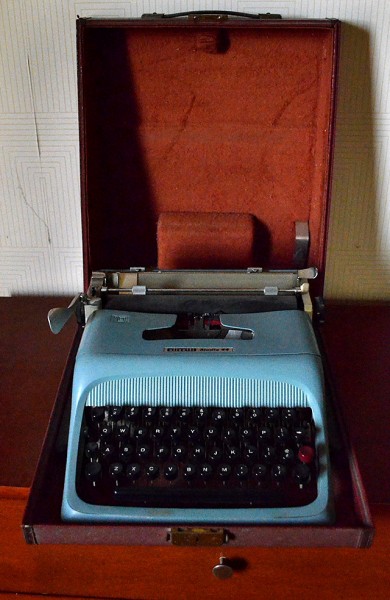 Brother Mark has my old portable Olivetti typewriter. I call it mine, but Dad never specifically gave it to me. I remember how proud he was when he brought it home: It was a cool blue color and lived in a red felt-lined case. He was impressed at how light it was and how good the keys felt.
Brother Mark has my old portable Olivetti typewriter. I call it mine, but Dad never specifically gave it to me. I remember how proud he was when he brought it home: It was a cool blue color and lived in a red felt-lined case. He was impressed at how light it was and how good the keys felt.
It ended up on my desk in the basement, typed a gazillion high school papers, then it went away to Ohio University with me.
Because Dad always had an office at home, in addition to one somewhere else, I always had access to a typewriter and a hand-cranked adding machine. That explains why my handwriting is lousy (and my math skills are equally bad).
An excuse to run typewriter photos
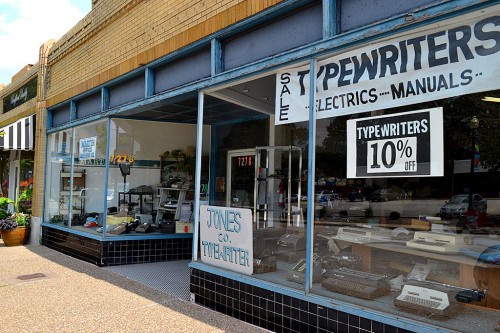 The lead shot is an excuse for me to run some photos I took July 3 when I was in St. Louis. On the way to meet Mary, an old friend from my Jackson Pioneer days, I saw an interesting typewriter repair shop on Manchester in Maplewood. I was running late (what’s new) and figured I’d never get back there again. As it turned out, I was meeting up with someone else the next day and passed the shop again. This time I stopped.
The lead shot is an excuse for me to run some photos I took July 3 when I was in St. Louis. On the way to meet Mary, an old friend from my Jackson Pioneer days, I saw an interesting typewriter repair shop on Manchester in Maplewood. I was running late (what’s new) and figured I’d never get back there again. As it turned out, I was meeting up with someone else the next day and passed the shop again. This time I stopped.
This is where the story gets embarrassing: I took a bunch of notes when I talked to the two brothers who owned the joint, but I must have left that notebook in Florida.
As it turns out, the repair place might not be there today. I did a quick web search and found a July 28, 2013, story that said Jones Typewriter might be leaving its Maplewood location because the rent had been raised too many times.
My own typewriter stories
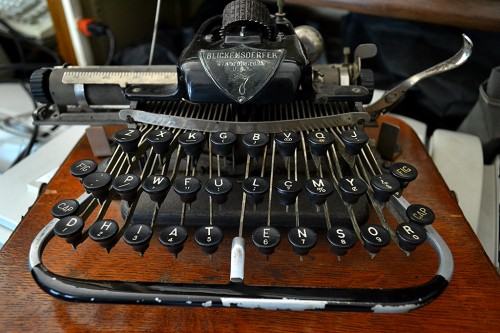 In the absence of real info about the Jones business, I’ll blather on about my other typewriter experiences, then run a gallery of photos from the place where typewriters and calculators go to be reborn, even if cannibalization must occur.
In the absence of real info about the Jones business, I’ll blather on about my other typewriter experiences, then run a gallery of photos from the place where typewriters and calculators go to be reborn, even if cannibalization must occur.
I don’t know how Mark ended up with the typewriter. I probably brought it back home after I left Athens. By the time I started working at The Athens Messenger, I had access to a full-blown typewriter and good workspace to do whatever schoolwork needed to be typed.
Special IBM Selectrics
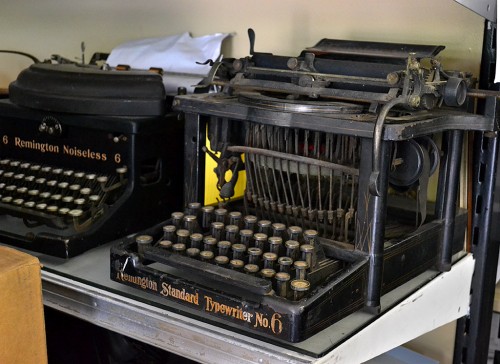 Not long after I started at The Palm Beach Post, the newspaper’s old manual typewriters were replaced with IBM Selectrics that had special characters on the magic spinning balls that put words on paper. Reporters would type their stories and the pages would be scanned and turned into type that was pasted up by the composing room. The special characters were formatting commands for bold, italic, and the like. You could use them as a regular typewriter if you avoided the special characters.
Not long after I started at The Palm Beach Post, the newspaper’s old manual typewriters were replaced with IBM Selectrics that had special characters on the magic spinning balls that put words on paper. Reporters would type their stories and the pages would be scanned and turned into type that was pasted up by the composing room. The special characters were formatting commands for bold, italic, and the like. You could use them as a regular typewriter if you avoided the special characters.
I kept putting in budget requests for more typewriters for the photo department, but they kept being rejected because “we’ll have lots of spares when we get the new pagination system.” After being turned down three times, I decided drastic measures needed to be taken.
Shhhh, here’s a secret
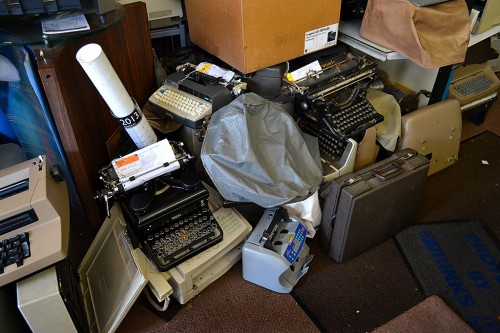 I’m going to tell you a little secret. I’m not with the company anymore; all of the old Selectrics are probably in a landfill, and I think the statute of limitations has run out on my transgressions, so I think I’m safe.
I’m going to tell you a little secret. I’m not with the company anymore; all of the old Selectrics are probably in a landfill, and I think the statute of limitations has run out on my transgressions, so I think I’m safe.
I would wander around the building until I saw a typewriter wearing a cover sitting in a corner or a hallway, obviously not in someone’s workspace. I would wait until nobody was looking, take off the cover, type, “Am I being used?” on a scrap piece of copy paper, then replace the cover.
If I checked back two weeks later and the note was still there, the typewriter would find itself in the photo department. Management never asked where the typewriters came from nor why I had quit asking for new ones. So far as I know, nobody ever reported any missing typewriters to security.
Besides, how could it be stealing if the property never left the premises, right?
Where’s the green ribbon?
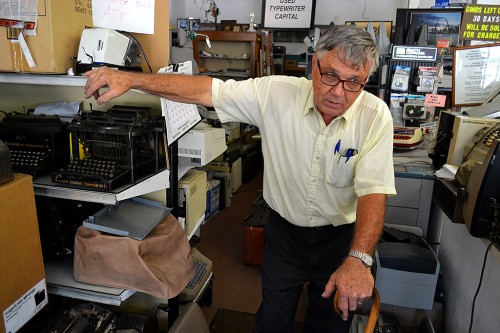 I just noticed that my old Olivetti at the top of the page has a conventional black and red ribbon. For those folks who have never used a typewriter, you normally typed with the black portion of the ribbon. If you were doing bookkeeping and wanted to emphasize a negative number, you’d switch to the red part. Hence, the expression, “in the red” for losing money.
I just noticed that my old Olivetti at the top of the page has a conventional black and red ribbon. For those folks who have never used a typewriter, you normally typed with the black portion of the ribbon. If you were doing bookkeeping and wanted to emphasize a negative number, you’d switch to the red part. Hence, the expression, “in the red” for losing money.
Dad had a thing for green. He had a green ribbon in his typewriters, painted his tools green and wrote with a green fountain pen. I did the same, for the most part.
I have a weakness for hardware and office supply stores. Since Missourian Office Supply was next door to the newspaper office and since I had an employee discount, I bought a selection of colors of ink cartridges for the fountain pen I used for school work. I think some of my teachers may have objected to my unconventional color choices, but I likely ignored them or switched to blue or black for their classes.
Thank goodness for felt tips
I had a few of the really old-fashioned fountain pens that had a bladder inside that you filled by pulling up on a lever while the pen’s tip was dipped in a bottle of ink. They leaked and always ran out of ink at the wrong time. Ink cartridges were much neater and you could carry spares. I abandoned ink pens when felt tips became common. They fitted my sloppy note-taking style better than fountain pens.
To show how old I am, I can remember that some of my grade school desks still had holes for ink wells. Or, they might have been to hold water for the dinosaurs to drink, who knows?
Hurricane gives, hurricane takes away
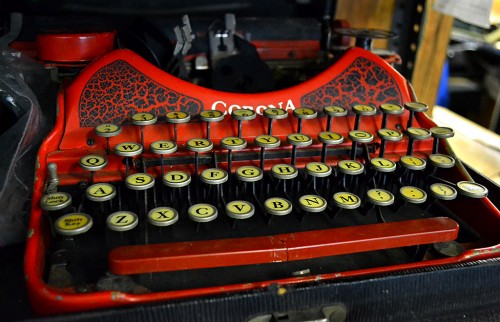 My favorite ballpoint of all time was a Papermate pen I found on the steps of The Post in 1979 when I came back from vacation because Hurricane David was barreling down on Florida. David was a Category 5 storm went it went over the Dominican Republic, so this looked like it was going to be the real deal.
My favorite ballpoint of all time was a Papermate pen I found on the steps of The Post in 1979 when I came back from vacation because Hurricane David was barreling down on Florida. David was a Category 5 storm went it went over the Dominican Republic, so this looked like it was going to be the real deal.
I drove 19 hours straight and pulled into West Palm Beach about 2 in the morning just as the winds were really starting to whip up. Fortunately for us, the mountains had knocked the storm down to a Cat 1. Still, we had some aluminum awnings blow off our house, never to be seen again.
I carried that pen every day until it slipped through a hole in my pocket while covering Hurricane Elena in 1985. I hope someone in Pascagoula, Mississippi, found it and loved it as much as I did.
Jones Typewriter Company photo gallery
The place was a cross between a repair shop and a museum. I hope the brothers and their typewriters found a new home if they did decide to move. There are a lot of writers out there who prefer turning out their works on a manual typewriter rather than a computer word processor. (I’m not one of them.) Click on any photo to make it larger, then click on the sides to move through the gallery.

